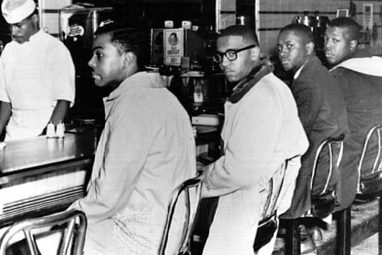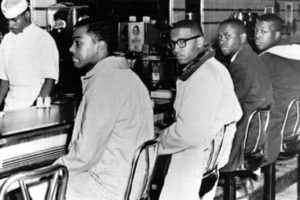Editor’s Note: We are proud to have a Bennett College student of Tamara Jeffries share this story with us. It is part of our recognition of Black History Month and we celebrate the role the Belle’s played in this pivotal part of the Civil Rights Movement.
By Azuree Bateman, Bennett College Student
Everyone who knows anything about the Greensboro sit-ins knows about the four freshmen from North Carolina A&T State University who sat down at the Woolworth’s lunch counter and began their peaceful sit-in on February 1,1960. But, there’s more to the story. The event that galvanized the youth across the nation wasn’t as spontaneous as history tells it. There were months of planning that went into the event that would change history forever. And a lot of that planning was done by women.
In the fall of 1959 things were happening at Bennett, the all women’s college adjacent to A&T. Sociology majors, Roslyn Smith and Gwen Mackel were learning of the unfair and unjust treatment black folks were experiencing at Woolworth’s, the five-and-dime store just minutes away from their campus: Black people were being denied service. Belles knew of the racially motivated interactions happening around their institution. Bennett alumna and former Bennett College president Esther Terry remembers, “They talked in classes about issues, about what was happening in the world.”
She recalls how Smith, her best friend who served as Bennett’s NAACP chapter president, came back to the dorm one day passionate about going out and making a change in the world.
Students from A&T would walk across the railroad tracks to attend the NAACP chapter meetings taking place on Bennett’s campus. This is where they would collectively forge their plan to desegregate the lunch counter.
Bennett’s President, Willa B. Player got word of what her students were doing and encouraged them to participate. She warned them that starting the protest before winter break was a bit impractical. With the upcoming Christmas holidays, few students would be on campus to keep the momentum up. The faculty and staff at Bennett were just as supportive as Dr. Player. Dr. Jared, Humanities and English Professor at Bennett College was in favor of the events being planned but encouraged the Bennett Belles to implore the help of men from A&T because women needed to be protected.
Following winter break, students returned to Greensboro ready to change the world. Player implemented rules for the sit-in: Students had to go in and purchase something from the Woolworth’s store so they wouldn’t be kicked out for loitering. As the sit-ins continued, more white people began to show up, but Player ordered her students to train for non-violent direct action.
On February 1, 1960, Blair, McCain, McNeil, and Richmond sat down at Woolworth’s. On February 2, Bennett Belles joined the Aggies at the lunch counter. During an interview Gwen Mackel recollects that she wasn’t as afraid as others. She was used to it. Her family had been run out of Mississippi before she attended Bennett. Mackel was no stranger to standing up for what was right. Her parents were civil rights activists. Her father was on the NAACP National Board during the Brown versus Board of Education case. Mackel said, “I knew my parents would support what I was doing. I did what I had to do because it had to be done.”
Students participated in shifts so no one would miss class. There were five girls assigned to each shift. As one shift was ending the newest shift would slide in to take their places. Belles wore hats and gloves down to Woolworth’s. “It was our armour and white men knew that we were Bennett women,” says Mackel. As the days went on, people were being arrested. Students were being arrested for sitting at the lunch counter. Just beyond Woolworth’s door were students who were picketting as well. At the peak of the movement. approximately 40 percent of Bennett’s student population were being detained in downtown Greensboro. (The chancellor of A&T, was not in favor of the demonstrations and ordered his students back to the campus.)
After months of sit-ins, Woolworth’s lunch counter was finally integrated on July 25, 1960. Together, Belles and A&T had successfully and collectively made their mark on the world from two historically Black in colleges in Greensboro, NC.


In addition to the Bennett women, there were also a couple of white women from the University of North Carolina at Greensboro. who joined the Bennett women and A&T men. They were disciplined.